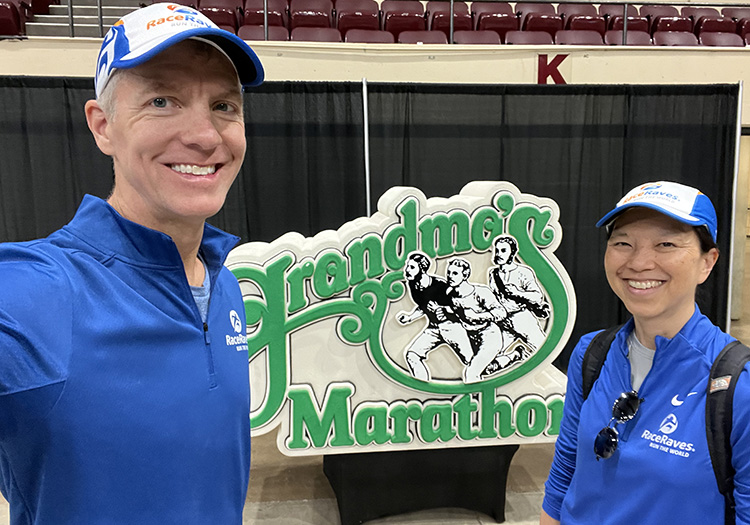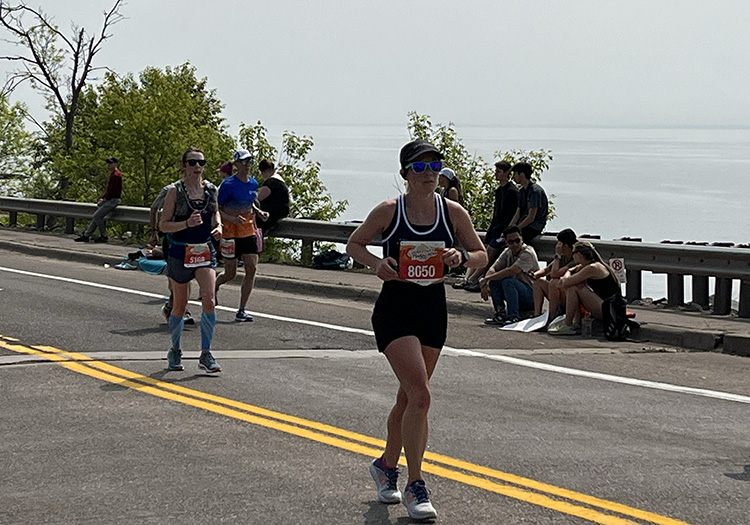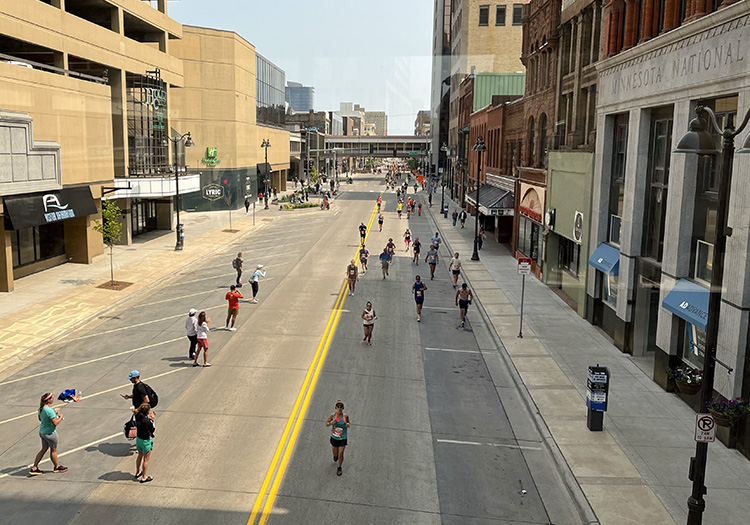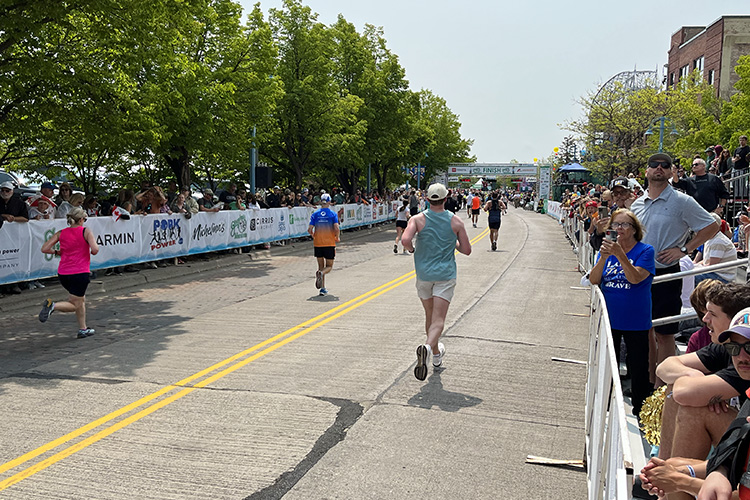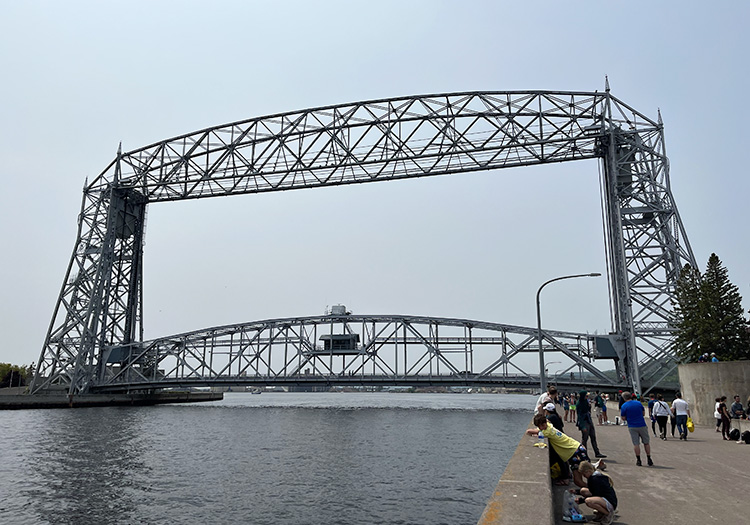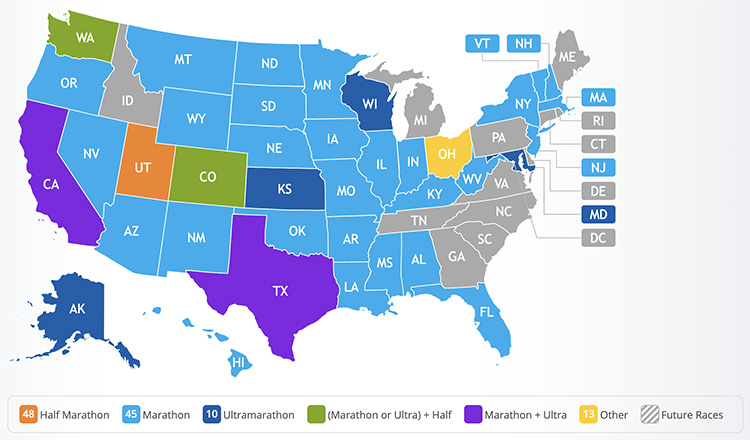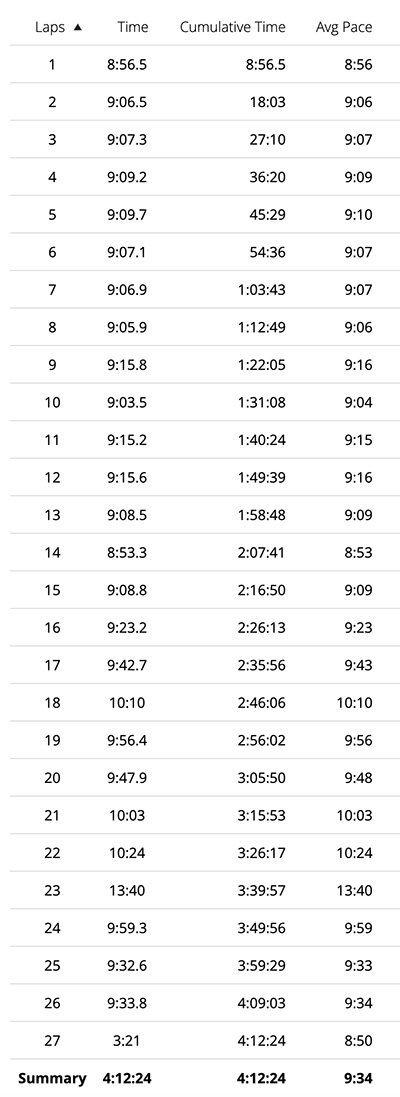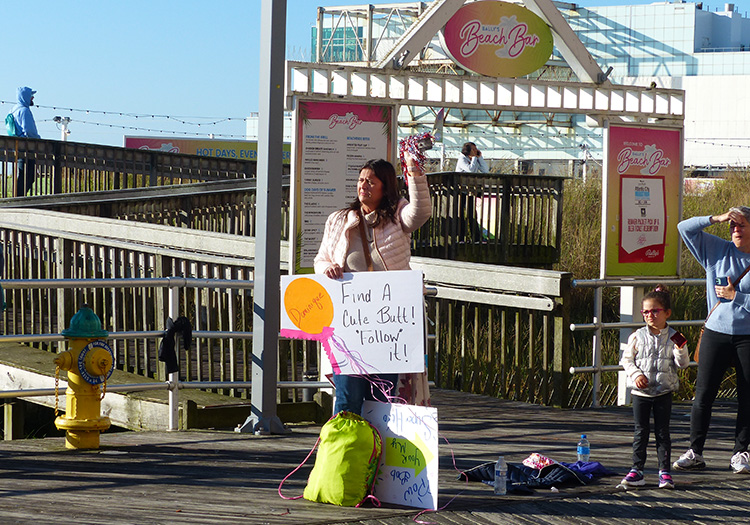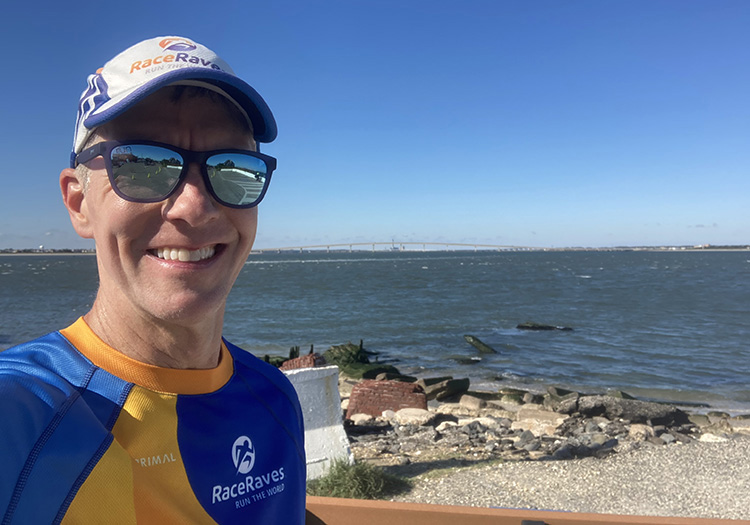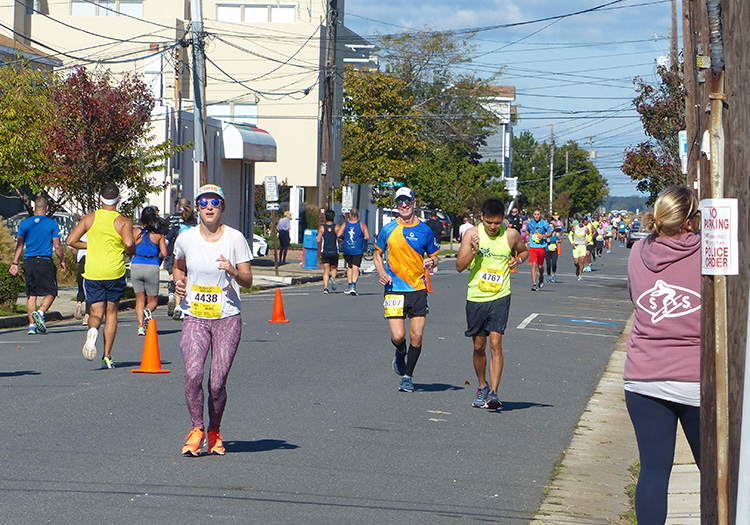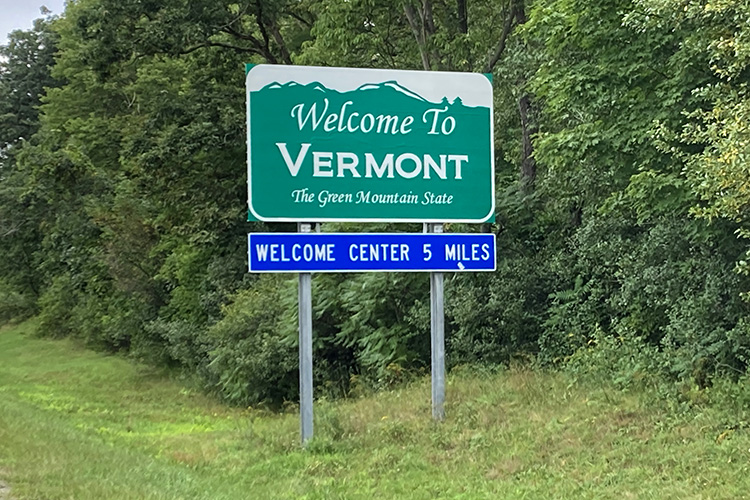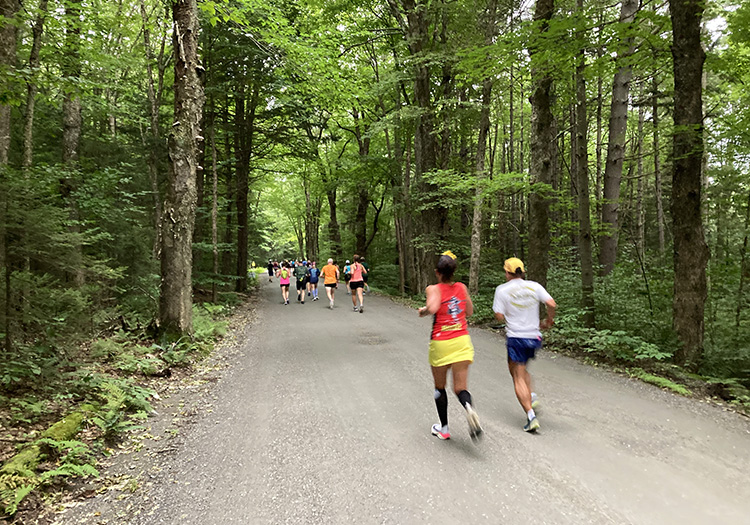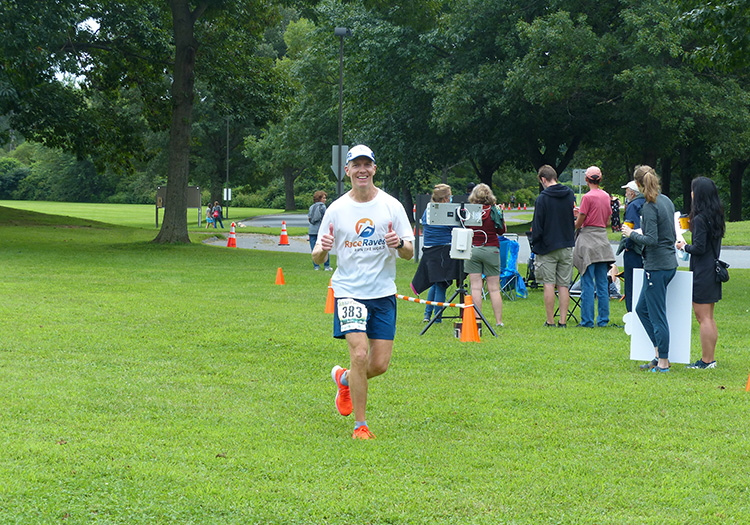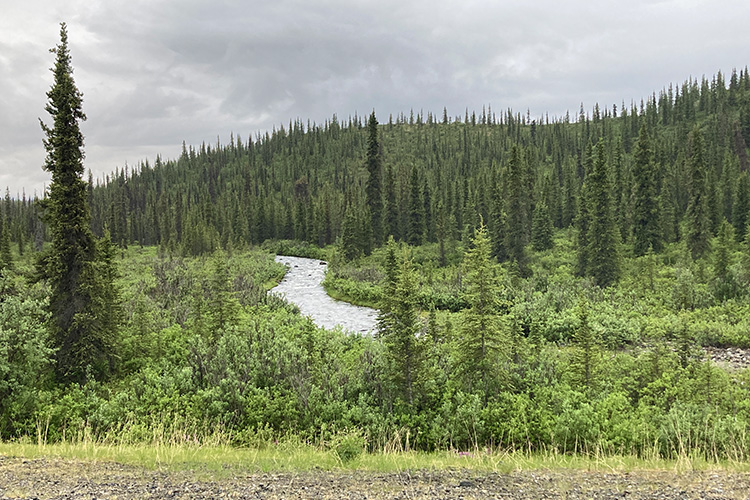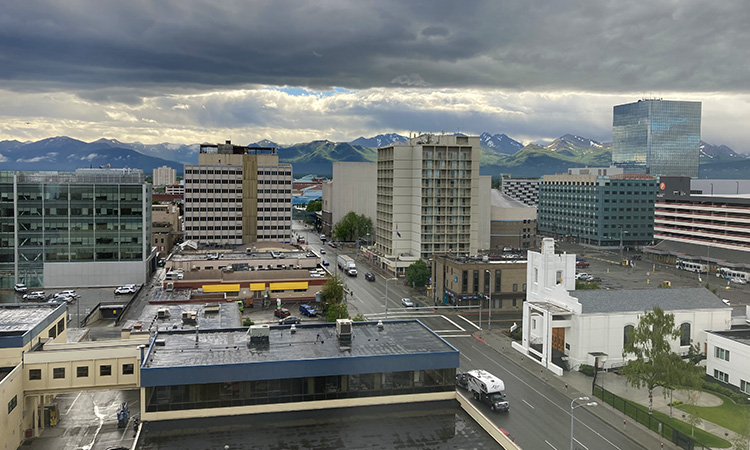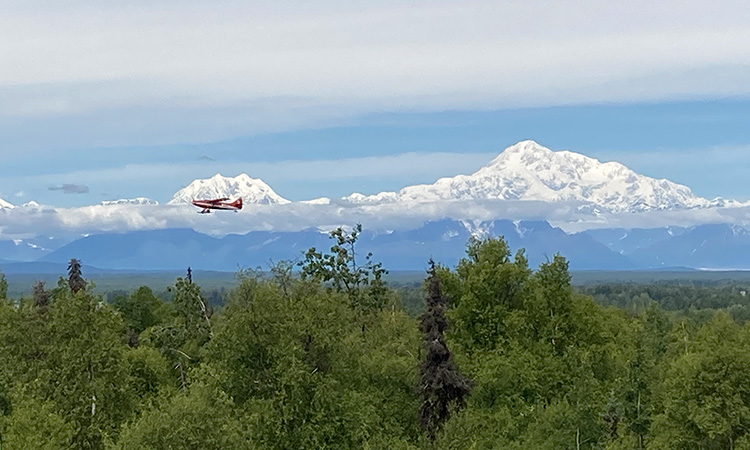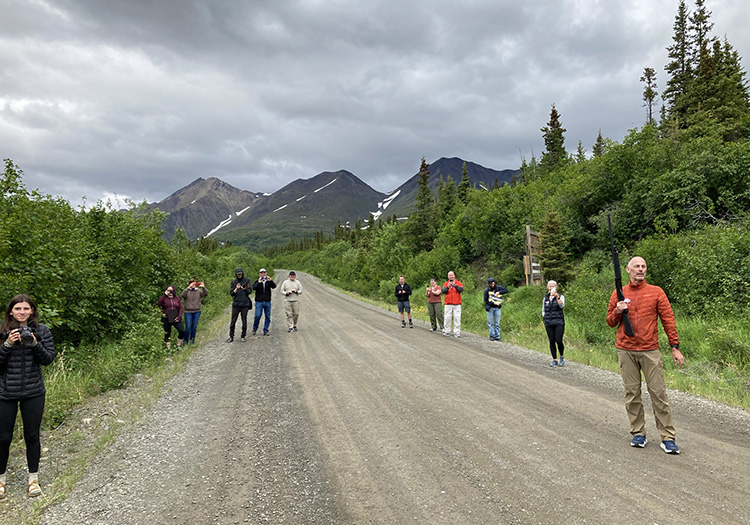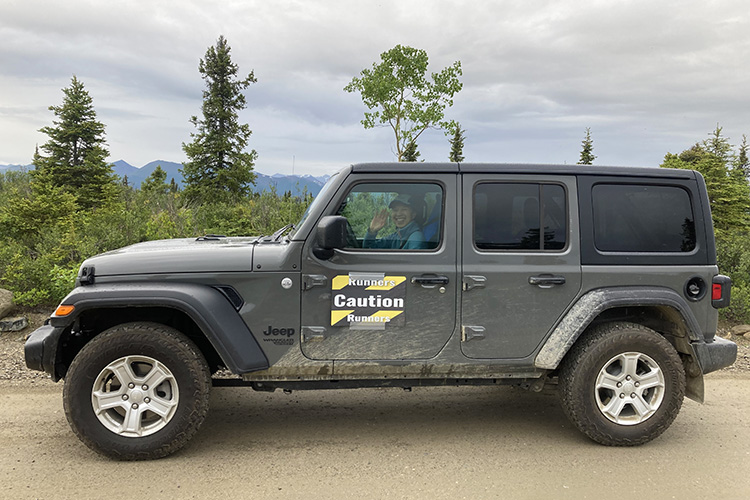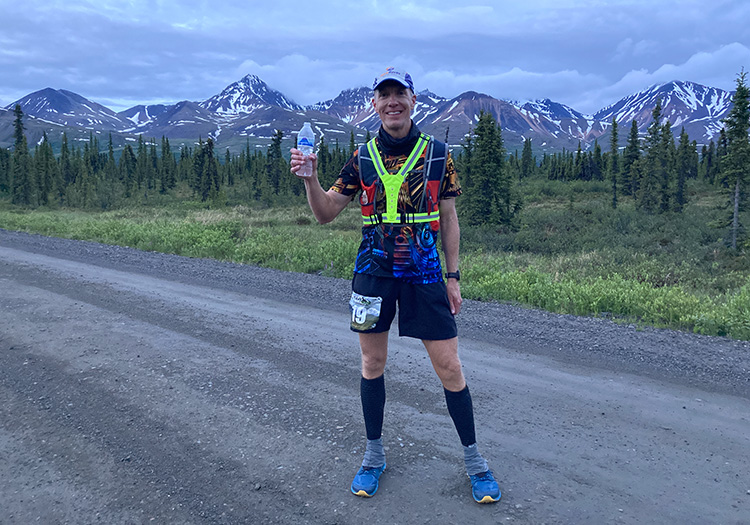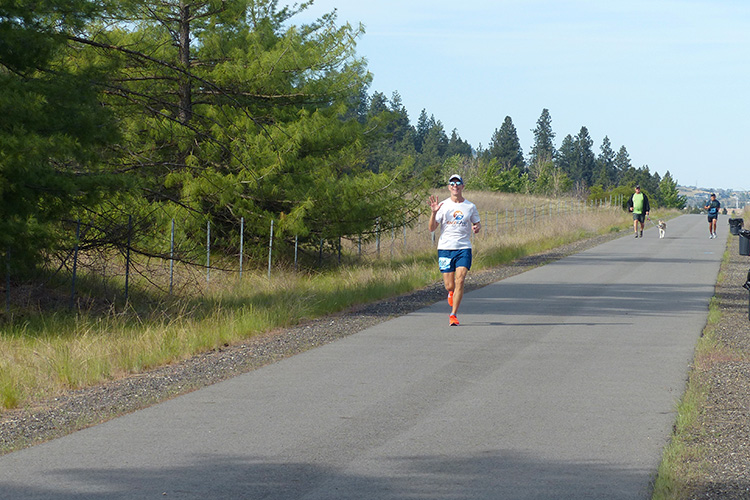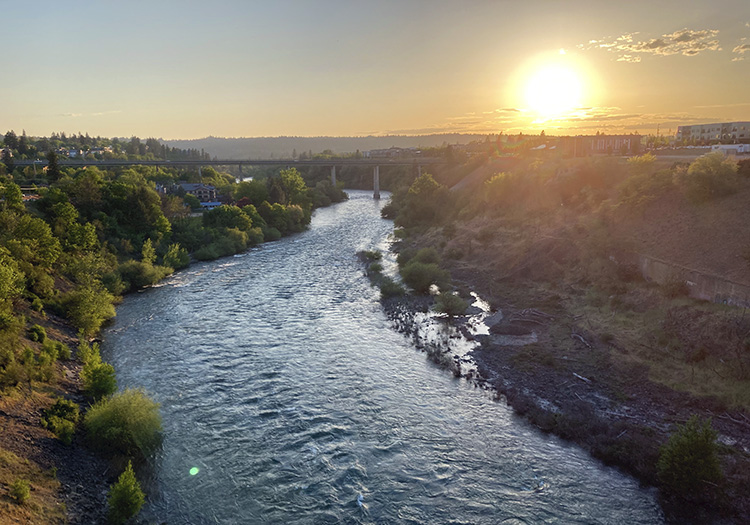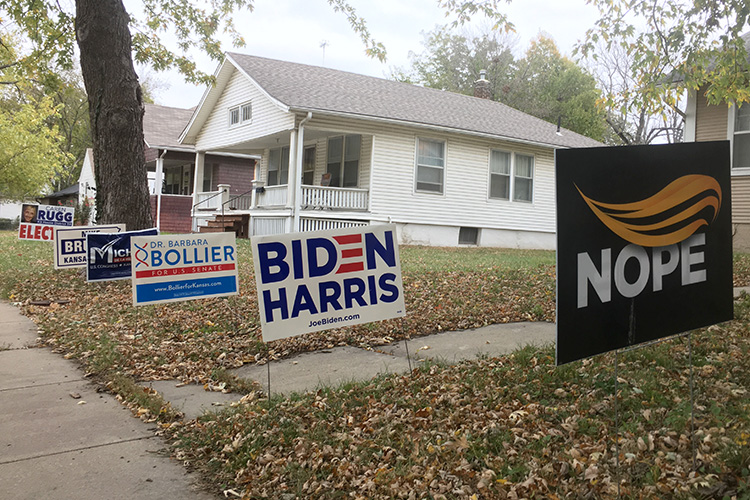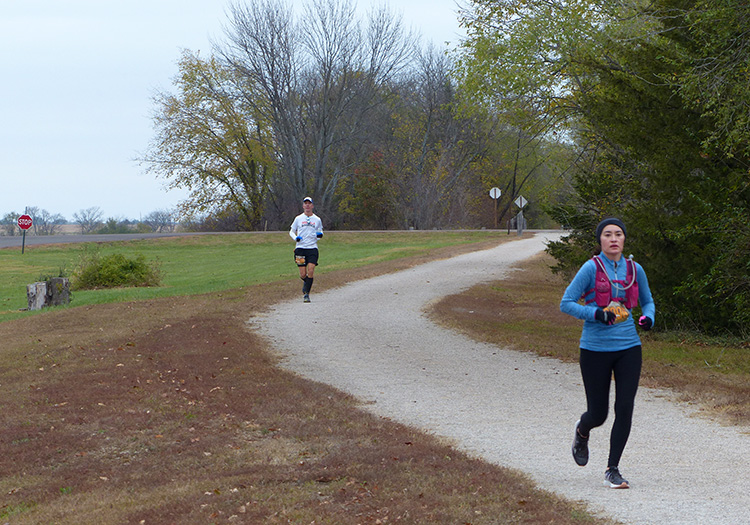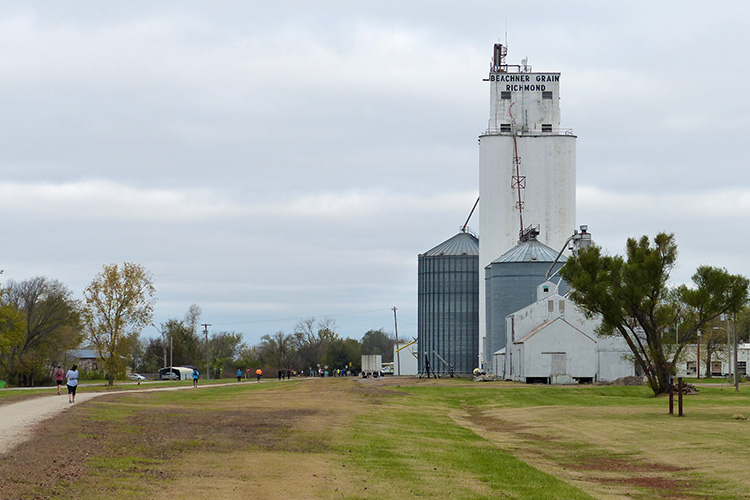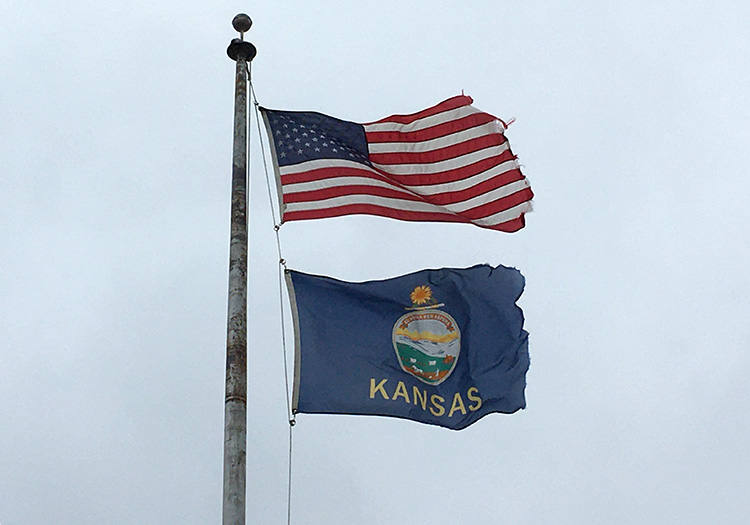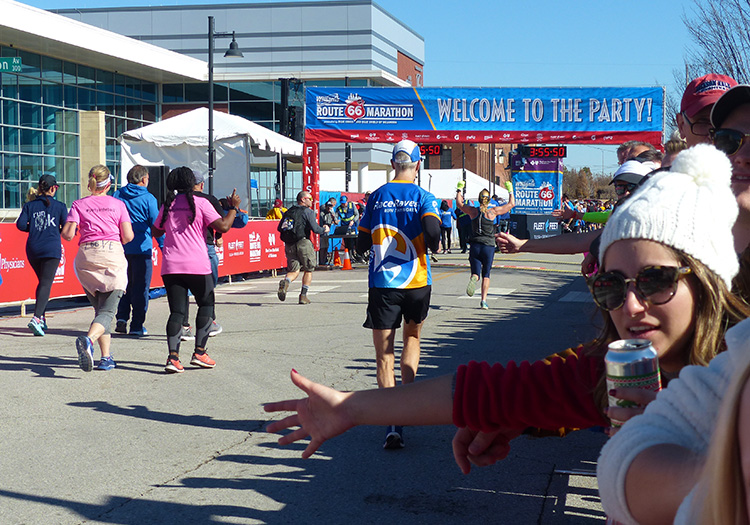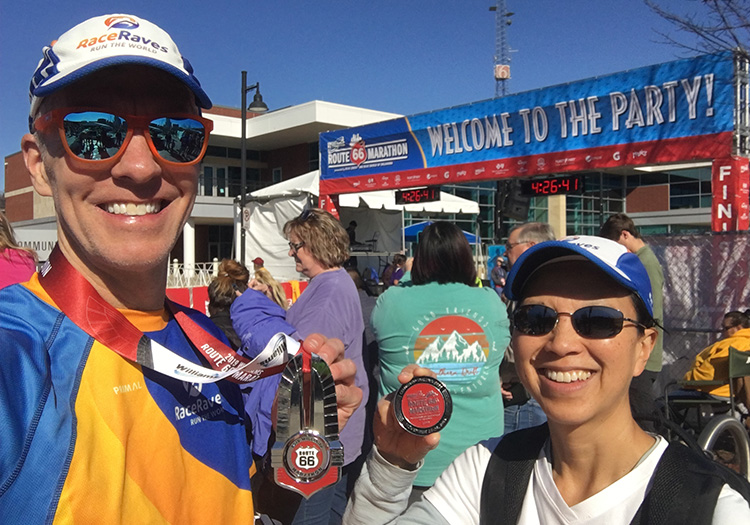I’m looking California, and feeling Minnesota.
– Soundgarden, “Outshined”
Like so many great ideas in American history, this one started in a bar.
In 1977, a group of runners met over beers in Duluth, Minnesota, and decided it would be fun to start their own marathon. After asking around and being turned down by several local businesses, the group found one business willing to ante up $600 to sponsor their race. That savvy investment earned the Grandma’s Saloon & Deli the title sponsorship of the fledgling marathon, and 48 years later the Grandma’s Marathon has grown into one of the nation’s largest and most popular marathons, one that sells out well ahead of race weekend.
The Grandma’s Marathon boasts a number of attributes that appeal to a 50 Stater like me. The first is its location: nestled in a beautiful setting along the North Shore of Lake Superior, Duluth is one of those places that’s synonymous with “small-town charm.” The second is its course which, thanks to its gently rolling profile and limited number of turns, is a perennial favorite among runners looking to qualify for Boston. The third is its status as the Best Marathon in Minnesota according to our 2023 RaceRaves Runners Choice poll. And the fourth is its scheduling in the middle of June, at a time of the year shunned by most other U.S. marathons due to the potential for hot & humid weather.
The early summer date is a distinct competitive advantage given that the majority of U.S. marathons—and many of my preferred marathons—fall in May and October, which makes scheduling for those two months a challenging game of “How much recovery time do I really need between marathons?” Never say never, but I’d rather not run a marathon that doesn’t excite me simply because it happens to fall at a more convenient time on the calendar.
In any case, Grandma’s would be my pick for Minnesota. I’d signed up in March—as late as possible ahead of a sellout—in the hopes that my previously injured leg would hold up to the demands of training for and running the London Marathon. Ironically, while my leg had made it through my final World Marathon Major with flying colors, the rest of me had not.
I’d flown home from London in late April and spent the next 18 hours in bed battling what I assumed to be COVID-19. Katie (who shared my symptoms) tested positive three days later, whereas I didn’t bother to test since I wasn’t leaving the house. As it turned out, this lingering reminder of London refused to go quietly, and it wasn’t until early June that my training runs started to feel relatively normal compared to the sluggish, labored miles of the previous month.
And so, two weeks later when our plane touched down at the Minneapolis–Saint Paul International Airport, I brought with me the baggage of decidedly lower expectations than I’d had three months earlier when I’d registered for the race. On the other hand, given the combination of my recent illness and a disheartening race day in London, I was euphoric just to be getting back to my 50 States quest after canceling plans to run the Providence (Rhode Island) Marathon in early May.
Getting to Know Duluth
From the state capital, we rented a car and headed north toward Duluth on I-35 (the same I-35 whose challenge I’d accepted in Kansas City and Des Moines five years earlier). For the next 2½ hours, the lush verdure of early summer filled my passenger-side window until we arrived at our destination on the North Shore of the world’s largest freshwater lake.
That evening serendipity stepped in, and we found ourselves enjoying one of the best meals of our 50 States travels so far at Va Bene, an understated Italian restaurant with fantastic food and an open-air deck boasting awesome views of the lake.
And just like that, our Minnesota adventure was off to a strong start.
On Friday we drove the West End and made the short climb to the top of Enger Tower, an 80-foot tall stone observation tower that offers panoramic views of Canal Park, the surrounding harbor and the neighboring state of Wisconsin. And we enjoyed lunch in an otherwise nondescript strip mall situated across the street from the immaculately landscaped Duluth Rose Garden and, beyond that, the brilliant blue expanse of Lake Superior. Location, location, location.
Having gotten a sense for the city’s waterfront district, we stopped by the pre-race expo at the Duluth Entertainment Convention Center (DECC) to pick up my bib number. With a purported 100+ vendors, the Grandma’s Marathon expo was—London notwithstanding—the largest I’ve seen in years. It was a throwback to what midsize race expos used to be before the pandemic.
Leisurely we strolled the aisles, pausing to chat with several race directors and our friends from Marathon Tours. Leaving the expo, we passed the colorfully decorated room that hosted the popular Michelina’s All-You-Can-Eat Spaghetti Dinner—admittedly a bargain at $16 for adults, $8 for kids—en route to our own dinner on the pier overlooking the harbor. I’d briefly considered Michelina’s offering, and I’m sure it would have been as good as advertised. To this day, though, I remain once bitten, twice shy thanks to my, um, interactive dining experience in Alabama ten years ago. 😬
Two Harbors and One Great Lake
Have I mentioned I’m a huge fan of Saturday races? After a relatively hedonistic (by pre-race standards) six hours of sleep, we awoke in the darkness of Saturday morning to clear skies and cool temperatures. If there’s such thing as a good day for a marathon, this was it.
After my usual light breakfast, we made the short walk (five minutes via pedestrian skyway from our room at the Holiday Inn & Suites Duluth-Downtown) to catch our separate modes of transportation outside the DECC. Katie would be riding the 5:30am North Shore Scenic Railroad spectator train to Two Harbors, a unique vantage point from which she’d be able to watch the runners at several stops along the course. She’d reserved her spot several months earlier at a cost of $90, which included breakfast with—for those determined to get their money’s worth—bottomless mimosas and Bloody Marys, plus a pass to the finish-line bleachers and a pair of Grandma’s-branded socks.
For my part, I’d opted against the train to Two Harbors since, due to high demand among runners for limited space, it would have meant getting up even earlier than our already perverse 4:30am wakeup call. Instead, I managed to avoid one of the standard yellow school buses in favor of a comfortable coach shuttle that hummed quietly through the brightening streets, navigating the marathon course in reverse as we caught glimpses out the window of volunteers setting up aid stations along the side of the road.
After a peaceful 35 minutes, the shuttle hissed to a stop and emptied its human cargo on Scenic Hwy 61 in Two Harbors where, standing alongside a Chevrolet dealership, the Grandma’s Marathon start line welcomed us to the party.
In retrospect, there looked to be plenty of room here on the highway for the start line to be relocated farther north, a move that would have added enough distance to enable a more direct route through Downtown Duluth to the finish line in Canal Park. Certainly, though, the parking lot of an auto dealership was a convenient space for thousands of marathoners to mill about aimlessly like nervous zombies for an hour.
Stepping off the shuttle, I headed immediately for the porta-potty line on the advice of my friend Krishna, a returning Grandma’s regular whom I’d last seen pre-pandemic at the 2019 Two Oceans Marathon in Cape Town. He’d warned me that the lines would be absurdly long, and he wasn’t kidding—it took me ~35 minutes to get in and get out. During that time I listened to pre-race announcements and the usual start-line favorites (“I Gotta Feeling” by the Black Eyed Peas, “Danger Zone” by Kenny Loggins, plus the theme from “Rocky”), heard a staff sergeant sing the national anthem, witnessed two F-16 fighter jets fly overhead, and cheered the start of the Wheelchair & Adaptive Athletes race.
Like so many races, one key step Grandma’s could take to improve the event would be more porta-potties. My inordinate wait time left me just over five minutes to strip down, hand my drop bag to a volunteer, and wiggle my way through the crowded start corral to stand alongside the 4-hour pace group.
I paused before entering the start corral to wave at Katie on the viewing deck of the North Shore Scenic Railroad, which sat silently on the tracks set back among the foliage on the opposite side of Hwy 61. Then I squeezed into the corral as the theme song from “Chariots of Fire” filled the crisp morning air, its uplifting overture hearkening me back to the race I’ll always associate with Vangelis’ iconic score—the Comrades Marathon in South Africa, the world’s largest ultramarathon and my personal favorite running event.
Seconds later the tightly packed mass of bodies loosened and surged forward in the direction of Duluth. Excited cheers filled the air, and the 47th annual Grandma’s Marathon (aka state 36 for me) was off and running. Thanks for the memories Two Harbors, it’s been real.
Quickly I fell into a rhythm with the 4-hour pace group. Given my post-London illness and suboptimal recovery, I didn’t expect to maintain a 4-hour pace for the entire 26.2 miles; rather, my goal was to stick with the group until the halfway point and then reassess my comfort level.
As the early miles ticked by, I glanced up occasionally from my 4-hour scrum to soak up the surrounding tranquility. Towering trees and tall grasses lined the road on each side, dual swaths of green as far as the eye could see interrupted by the occasional modest residence or small-but-vociferous gathering of spectators. Such was the scenery for the first ten miles as we chased the horizon, the road seeming to grok that the shortest distance between us and Duluth was a (very) straight line.
I focused on staying relaxed by settling into a rhythmic breathing cadence—inhale for 3 steps, exhale for 2 steps. So far, Minnesota’s North Shore was the perfect remedy for the claustrophobic chaos of London.
The Grandma’s Marathon surprises and delights with thoughtful details that set it apart from other marathons, case in point its mile markers. Rather than ground-level placards that are designed to be seen only in passing, the Grandma’s organizers float large yellow balloons (blue for half marathoners) tied to long ribbons on each side of the road so they’re visible from afar. Along an extended straightaway like Hwy 61, I felt a tiny shot of adrenaline each time I’d see those balloons approach in the distance.
I’m always amazed by how much energy runners are willing to waste during a marathon, an undertaking that requires nearly every ounce of energy you’ve got to succeed. One fellow to my left kept whooping loudly in response to personalized spectator signs—”GO ELLIE!” he’d scream, or “GO JORDAN!” as if he were seated in the finish-line bleachers rather than running the race. Never mind that neither Ellie nor Jordan was within earshot of his enthusiasm; he may as well have been cheering for the trees. Dude, I thought wryly, that’s energy you’re going to wish you had in a couple of hours.
The chatter around me subsided until we were left with only the voices of runners conversing with the 4-hour pacer. One woman in our group asked, “What’s your name, pacer?” “Danny” came the response. She then proceeded to grill Danny on his strategy, which I’d assumed would be something along the lines of “Run at a pace of just under four hours until we all cross the finish line.”
“What’s your strategy for the hills?” she asked. “There are hills here?” Danny joked. Ignoring his attempt at humor, she reminded him unhelpfully that he had a big group running with him and a lot of folks counting on him. And I felt a pang of sympathy for poor Danny, an unpaid volunteer who was giving back to the running community by helping the rest of us achieve our goals. In the world of the type-A marathoner, no good deed goes unpunished.
The course rolled slightly along its southward trajectory, its scenery as unchanging as any race I’d run—and this was a good thing. In mile 7 we caught our first glimpse of Lake Superior peeking through the trees to our left; it wasn’t until mile 10, though, that the lake emerged in its full glory to wow us with its pristine shoreline and sparkling surface, both of which would remain hidden behind trees for most of the race.
A gentle cooling breeze off the lake helped keep things comfortable as the temperature crept slowly upward toward its projected high of 74°F. This was my kind of race, and I wished again that my post-London regimen had lent itself to training more regularly at a sub-4-hour pace.
To my mind, no endeavor demands a more consistent work ethic than running 26.2 miles. The simple truth is, you cannot fake a marathon. There are no breaks in the action, no teammates to lean on, no timeouts to catch your breath. When the starter’s pistol fires, you’re either ready or you’re not—and even then, race day may not go according to plan with so many variables out of your control. In an age of so much performative BS from politicians and personalities, its brutal and unapologetic authenticity is one of the reasons I love the sport of running.
Feeling Minnesota
I continued to run with the 4-hour pace group as we reached an area lined with blue porta-potties, aka the Garry Bjorklund Half Marathon start line. Here Bon Jovi’s “Livin’ on a Prayer”—predictable to be sure, but always welcome—blasted from the sidelines. I told myself the “fluff” miles were over while trying to focus on the silver lining: one half marathon down, one to go. I knew, though, that things would get tougher from here. Unfortunately, this was all part of the process of getting back to where I wanted to be, one step at a time.
Krishna would later share the story of one spectator in this area yelling “ALL DOWNHILL FROM HERE!” which prompted Krishna, a speedy Grandma’s Marathon veteran who knows the course well, to yell back reflexively, “A LIE!” Any marathoner who’s had to endure obnoxious spectator cries of “Almost there!” at mile 3 can appreciate Krishna’s candor.
By mile 15 I realized that continuing to push a sub-4 pace would lead to a very rough 11 miles, in part because the day was warming (thank you, cool breeze!) and I needed more frequent aid station stops. And so, pulling back the throttle to a more comfortable position, I watched the 4-hour pace group slowly recede into the distance.
Miles 15 and 16 felt largely uphill, though this was apparently due less to reality and more to perceived effort—looking at my Garmin tracing, the actual hills wouldn’t arrive until later. And in mile 18 I was forced to pause and do a few leg lifts to loosen my tightening quads. Just one more thing, I told myself, that would improve with further training. C’est la vie. There’s nothing quite like being undertrained to make you appreciate the epic challenge of running 26.2 miles.
I was impressed and heartened by the number of boisterous spectators lining Hwy 61 or cheering on the runners from comfortable lawn chairs in their front yards. Their exuberance was a welcome pick-me-up along an otherwise quiet course that was largely devoid of music or other entertainment, though I’d be remiss not to give a shout-out to the solitary tuba player, even if I can’t recall what they were playing or whether a solo tuba did the song justice.
I glanced up at one point to see my companion from the 4-hour pace group, the woman who had been interrogating pacer Danny, now running just ahead of me and well behind the 4-hour group. Bill Rodgers was right, I mused. The marathon will humble you. And we’ve all been there.
As fatigue set in and my lower back tightened a bit, I took time to walk through the aid stations which likewise allowed me to stretch my quads and gather my wits. I forced an energy gel down with water in two installments, my stomach protesting its warm and gooey sweetness. While I’ve typically had better luck at longer distances (like the Denali 100K in Alaska), after 50+ marathons I still struggle to dial in my nutrition on race day. On cooler days I skip it altogether, a strategy that flouts conventional wisdom but which always seems to yield the best results.
On the bright side—and this was the best news of the day—my previously injured leg and the sprained foot that had derailed me in London both felt strong and healthy.
Miles 16–20 were a no-man’s land of discomfort, fatigue rearing its ugly head to the extent that it was impossible to ignore but not overwhelming enough to make me walk. I kept my eyes on the road five feet ahead of me, trying to marshal my reserves one mile at a time, then one step at a time. Where tree cover hung over the road, I ran on the shoulder to avail myself of the shade. Occasionally the road would exit the trees to reveal Superior’s majesty on full display, the light breeze creating delicate ripples across the water’s surface.
Katie stood waiting just short of the mile 19 marker on the Lester River Bridge, where she enjoyed her own sweeping view of the lake. As if riding the spectator train from Duluth to Two Harbors and back hadn’t been enough show of support, here she was out on the course for a second time, having walked to the hotel to collect the car and drive herself to mile 19. And now, as I leaned against her to stretch my quads, she asked in her earnestly supportive way, “Are you enjoying yourself?” I think we both realized the absurdity of the question as soon as it came out.
I admitted that no, I was not in fact enjoying myself. Then I bid her farewell and told her I’d see her at the finish… eventually. This was going to be a long, slow seven miles.
As the miles mounted and we reached the outskirts of Duluth, I passed a surprising number of runners-turned-walkers. Granted I was further back in the pack than usual, but still there were quite a few walkers of all shapes and sizes. Also conspicuous was the number of discarded sponges on the ground. For my part, with temperatures in the 60s I never felt in need of a cold sponge, plus I didn’t want to risk wiping off my sunscreen. As pale as I am, skin cancer and melanoma concern me much more than warm temperatures.
For whatever reason—a second, third or fourth wind perhaps, or maybe I’d entered the eye of the hurricane—life after mile 20 began to look a bit rosier as a brief surge of momentum propelled me forward. I even tried to fall in behind the 4:05 pacer for ¾ of a mile or so before rejecting that idea. During that stretch, we passed one group of young guys on the sideline who saw the 4:05 sign and broke into a raucous chant of “PA-CER! PA-CER! PA-CER!” as he played to the crowd, pumping the sign up and down like a drill team leader wielding a baton.
Modest one- and two-story homes now dotted the landscape with increasing frequency, many of them clad in the protective exterior siding common to colder climates. Approaching the mile 22 marker, my mile times had crept up into the ten-minute range as I struggled to lift my quads, which now felt like solid blocks of granite.
And so, rather than plod along in a bitter haze and with notorious Lemon Drop Hill (named for a now-defunct restaurant that closed in 1988) looming directly ahead I slowed to a walk, took a few deep breaths, and allowed myself to relax. When life gives you Lemon Drop, make lemonade. I didn’t want to let my lack of preparation snowball on me and ruin an otherwise pleasurable run. After taking mile 23 to catch my breath, I’d have only 5K (3.1 miles) or so remaining, and at that point I could focus my remaining energy on pushing through Downtown Duluth to Canal Park. Sure I wanted to finish strong, but realistically I was here to enjoy Minnesota, not to earn an Olympic Trials Qualifying time.
(On that note, two-time Grandma’s winner Dakotah Lindwurm did run an OTQ in Duluth, setting the stage for her third-place finish at last month’s Olympic Marathon Trials which earned her a spot on this summer’s Olympic Marathon Team in Paris 👏)
Exiting the highway and transitioning to London Rd, we entered a more commercial stretch where the sudden appearance of hotels, fast-food restaurants and gas stations (Whoa, Minnesota still has enough water for car washes!) welcomed us to Duluth proper. As much as I’d appreciated the blissfully monotonous greenery and stunning lake views of Scenic Hwy 61, I was gratified now to enter more urban surroundings, a clear indicator that the end was near.
Had I not chosen to walk this stretch, I might have missed my favorite spectator sign of the day; “F*CK THIS SHIT” it read in large letters, with “KEEP RUNNING” written inconspicuously along the sides. More than any other sign I’d seen—NO, I wasn’t kicking ass-phalt and NO, all this sweat wasn’t my fat cells crying—this one spoke to me. Despite my exhaustion, I may even have cracked a smile.
Approaching the mile 23 marker I once again broke into a trot, and moments later we made a right turn away from the lake and onto the block where Katie and I had eaten lunch the day before. This first turn of the day produced an unexpected surge of adrenaline that carried me up the hill to an almost immediate left turn on Superior St, which would lead us into the heart of the commercial district and Downtown Duluth.
From there the scenery became more familiar as we passed the Duluth Running Store, Va Bene (site of our best meal in Duluth), and the collection of buildings housing the centerpiece of Superior Street, the state-of-the-art Essentia Health St. Mary’s Medical Center. The latter’s sleekly modern design, with its bold curves and floor-to-ceiling windows, looked distinctly out of place among its more traditional, low-key neighbors. On the opposite side, Lake Superior remained our ever-loyal companion, its shimmering surface guiding us homeward to Canal Park.
Passing the Medical Center, we seemed to travel back in time as we entered the multi-level red-brick storefronts of the city’s aging downtown district. Downtown Duluth more closely resembled the one-horse, one-street downtown of tiny Ottawa, Kansas than it did a modern urban downtown. Despite being listed on the National Register of Historic Places, during our stay I couldn’t put my finger on anything that struck me as particularly special about Downtown Duluth. Aside from the crowds on race day, that is…
“Gopher” Broke
As we approached downtown, the crowd support grew in both size and intensity. Spirited cheers welcomed us to Duluth while I continued to focus one block at a time on locating the next yellow balloon/mile marker in the distance. Overhead the occasional glass skywalk—a winter necessity in the Gopher State—connected buildings on opposite sides of the street, offering a convenient vantage point from which to watch the runners below.
Controlled chaos was playing out at the intersection of Superior and Lake Street, where race officials and volunteers worked to prevent spectators (and potentially runners) from cutting across the course on Lake Street as a shortcut directly to the finish line in Canal Park. A shout-out of gratitude to the folks in charge of crowd control, because spectators crossing willy-nilly in front of exhausted marathoners at mile 25 could have been an accident waiting to happen.
Just past the mile 25 marker our third turn of the day led us down a short transition zone of bricks, over I-35 and the train tracks, past AMSOIL Arena (home of the University of Minnesota-Duluth Bulldogs) and the Great Lakes Aquarium, and into Canal Park. “Half a mile to go!” yelled a spectator to my right. Nice, I thought, though if there’s one thing I’ve learned from my 50+ marathons, it’s never to trust the spectators. No offense and I appreciate the support, but bystanders tend to have a more nonchalant sense of what “almost there” means than someone who’s already run 25.5 miles.
Duluth’s signature architectural landmark, its iconic Aerial Lift Bridge, came into view across the water, lifting my spirits momentarily as we curved along Harbor Drive. Come on adrenaline, do your stuff! I dug deep, tapping into what little remained of my energy reserves. “Half a mile to go!” shouted another spectator. Huh?
Winding our way around Canal Park with Downtown Duluth now visible across I-35, we passed the hulking steel façade of the SS William A. Irvin. Once the proud flagship of U.S. Steel’s Great Lakes Fleet of bulk freighters (or as we Angelenos know them, “Lakers”), an enormous banner now hung across its port side encouraging visitors with the promise of “KIDS FREE WITH PAID ADULT.”
A third voice rang out from the sidelines: “Half a mile to go!” People, make up your minds! Fatigue notwithstanding, I couldn’t help but appreciate this well-meaning display of Midwestern hospitality.
Another turn AND… our tour of Canal Park continued. Having failed to study the course map carefully (the first 25 miles was basically a straight line, after all), I didn’t realize we’d saved all our turns for the last mile. Or so it seemed. We’d passed the mile 25 marker, like, forever ago… so where was the damn finish line?
At long last we arrived at Canal Park Dr, where a right turn led onto the final straightaway. Directly ahead the finish line beckoned us home, the imposing steel skeleton of the Aerial Lift Bridge towering in the background. Somehow, I was coherent enough to pick Katie out of the crowd lining the street, her cheers propelling me forward across the finish line and out of my pain cave in a hard-earned time of 4:12:23.
(Lest there be any doubts as to the city’s support for this race, stenciled permanently on the street at the location of the finish arch are the words “GRANDMA’S MARATHON FINISH.”)
Wobbling to a stop, I paused to gather my wits and bask in the moment before continuing through the finish chute where I gratefully accepted my medal, finisher shirt and heat sheet from volunteers. And speaking of volunteers, I can vouch that the lake wasn’t the only thing that was Superior on this day. From start to finish, everyone was incredibly friendly and helpful including Joyce at the med tent who, as I hobbled past in search of a comfy place to collapse, kindly told me how good I looked for having just run a marathon.
The finishers area offered a variety of fueling options including bagels, yogurt, fruit, chips & snacks, pork sticks, and chocolate milk along with beer and non-alcoholic beverages at the post-race celebration. And true to form, my stomach would have none of it. So I grabbed several bottles of water along with my drop bag and reunited with Katie, before claiming a grassy spot alongside (where else?) Grandma’s Saloon & Grill, a stone’s throw from the lake and the Aerial Lift Bridge.
Having started an hour and 45 minutes before us, most of the half marathoners had long since finished and gone home, leaving ample space in Canal Park for marathoners to spread out and relax.
And relax I did, as much as my exhausted body would allow—it took me a while before I was able to move comfortably under my own power. Unfortunately, I had neither the energy nor the desire to make the 15-minute walk to nearby Bayfront Festival Park for the post-race party. I was spent, and aside from my usual post-race bottle of Tailwind Recovery Drink, I knew I had no choice but to wait out my body and let it dictate its nutritional needs on its own timeline.
Luckily for me, as the host hotel for the elite runners, the Holiday Inn & Suites where we stayed offered complimentary sports massage services for race weekend. So that afternoon I took the opportunity to schedule a relaxing post-race massage, a decision which did not suck. Then we showered and met Krishna for dinner at Ursa Minor Brewery, a bustling spot on the north side of town and an easy five-minute drive from Canal Park.
Over dinner and drinks, we compared notes from the day and caught up on each other’s lives since our last in-person meeting at the Two Oceans Marathon in Cape Town in 2019. We also discussed his own burgeoning desire to run a marathon in all 50 states, which is good news for me since it gives us an easy excuse to meet again before another four years pass. The evening was another compelling reminder that beyond the miles, the medals and the memories, this 50 States quest gets its power from the people.
From a preparation and performance perspective, Grandma’s was hardly ideal—given the option, certainly I’d have chosen not to get sick after London, my first marathon in 16 months. At the same time this was clear progress, a milestone in my mental and physical journey back to marathon fitness. I’d finished stronger (and less injured) than London as my body continues to relearn the art and science of running 26.2 miles. As they say, if it were easy everyone would do it, instead of sitting on the couch warning the rest of us it’s bad for our knees.
So there you have it—state 36 is in the books, and one of the nation’s most charming destinations is off the board. On an epic summer day along Minnesota’s scenic North Shore, small-town hospitality and big-city choreography joined forces with the world’s largest freshwater lake to produce a race day I’d highly recommend.
Because this is one Grandma that just gets better with age.
BOTTOM LINE: Honestly, it’s tough to find fault with the Grandma’s Marathon. Sure, I could complain that true to the law of supply and demand, local hotels and businesses jack up their prices for race weekend—case in point, our room at the Holiday Inn & Suites in Downtown Duluth cost nearly $400/night, more than a room at the world-class Four Seasons Hotel in Sydney, Australia. And maybe I could argue that scheduling a race in mid-June dares Mother Nature to bring the summer heat. But at that point I’d just be looking for reasons to kvetch.
Instead, I’ll say that Grandma’s is where small-town charm & hospitality meet big-city efficiency & logistics, with the world’s largest freshwater lake as its centerpiece. It’s a definite “feel good” race, and in that sense it reminds me of a Fargo (ND) or a Missoula (MT) or a Clarence DeMar (NH), though Grandma’s hosts a significantly larger field than its small(er)-town counterparts. So it’s no surprise that this year’s sellout was the fastest in the race’s 48-year history, because this Grandma keeps getting better with age.
The tranquil, tree-lined course parallels Lake Superior for 23 miles without a single turn before finishing at Duluth Harbor, a stone’s throw from the city’s most iconic architectural landmark, the Aerial Lift Bridge. And the lake’s not the only thing that’s Superior, as every volunteer I met was enthusiastic, supportive and helpful. Grandma’s is a major boon to the local economy, and clearly the city rallies around its race. As well it should— as the tenth-largest marathon in the U.S. in 2023, the pride of Duluth punches well above its weight class and merits strong consideration as the biggest small-town race in America.
Dining Tip: For a memorable meal in Duluth check out Va Bene, an Italian eatery that boasts an enclosed solarium and outdoor deck overlooking Lake Superior.
PRODUCTION: Show me a perennially popular race weekend that hosts nearly 20,000 runners in a town of 86,000 residents, and I’ll show you a level of professional excellence that’s second to none. When it comes to logistics and runner satisfaction, the Grandma’s team does pretty much everything well. In addition to getting the big important things right, the organizers show a thoughtful attention to detail that clearly comes from a legit combination of expertise and caring.
Nothing about race weekend feels half-assed, from the bustling expo (among the best I’ve seen outside a World Marathon Major), to the start-line shuttle buses (comfortable and on time), to the highly visible balloon mile markers along the course, to the strategically positioned aid stations (officially every two miles for the first 20 miles, then every mile to the finish), to the finish-line gathering in Canal Park. I also heard good things about the post-race celebration in Bayfront Festival Park, though I didn’t attend. The race even offered a separate train and viewing experience for spectators (at $90 per person, including a pair of Grandma’s Marathon-branded socks) that Katie would highly recommend.
SWAG: The 2023 Grandma’s Marathon medal is a well-crafted keepsake and an instant favorite. Suspended from a bright orange ribbon, the medal is a hefty handful of silver-plated hardware that depicts a scene of summer in Canal Park starring Duluth Harbor and the Aerial Lift Bridge. Adding a splash of color are the red race name and blue state outline of Minnesota with red dot showing the location of Duluth. Meanwhile, the finisher shirt—which as the name suggests runners received only after crossing the finish line—is the typical short-sleeve tech tee, though its attractive dark blue color makes it more appealing (and more likely to be worn) than the usual black, white or brightly colored alternative.
Updated 50 States Map:
RaceRaves rating:
FINAL STATS:
Jun 17, 2023 (start time 7:45 am)
26.38 miles from Two Harbors to Duluth, Minnesota (state 36 of 50)
Finish time & pace: 4:12:23 (first time running the Grandma’s Marathon), 9:34/mile
Finish place: 3,470 overall, 125/235 in M(50-54) age group
Number of finishers: 6,690 (3,933 men, 2,744 women, 10 non-binary)
Race weather: cool & clear (57°F) at the start, warm & sunny (70°F) at the finish
Elevation change (Garmin Connect): 403 ft gain, 520 ft loss
Elevation min, max: 604 ft, 736 ft

